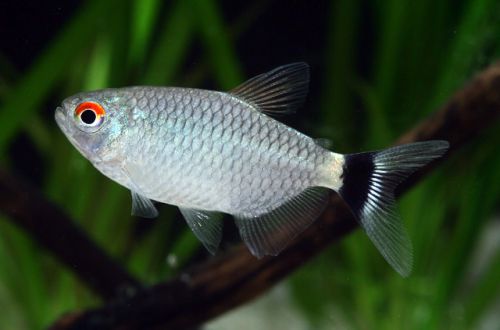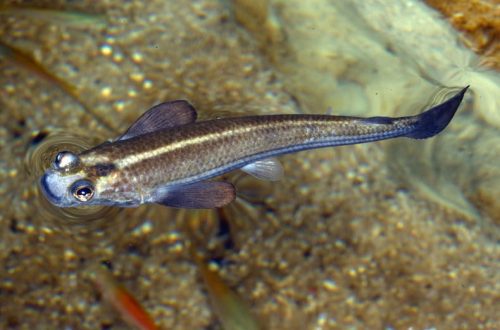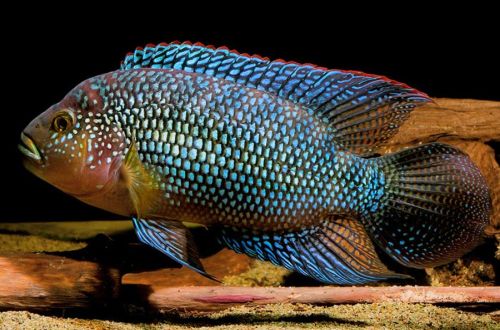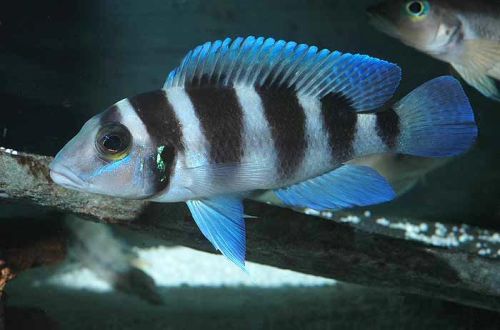
Red Eyed Tetra
Philomena, Red-eyed Tetra or Moenkausiya Red-eyed, scientific name Moenkhausia sanctaefilomenae, belongs to the Characidae family. It is popular all over the world, one of the most affordable and popular types. Easy to maintain, not whimsical, able to decorate any aquarium. Recommended for beginner aquarists.

Contents
Habitat
This species is widespread in the river systems of South America in the tropical zone, found in Brazil, Peru, Paraguay, Bolivia, etc. They prefer clean rivers with dense vegetation, flowing under the canopy of the tropical forest. Currently, almost all fish presented in the trading network are supplied from Asia.
Description
Philomena has a typical body shape, characteristic of most Tetras, an adult does not exceed 7 cm in length. The color is silvery with large scales, the fins are transparent, the base of the tail is decorated with yellow and black stripes. A distinctive feature that gave the name to the species is the red pigmentation of the eyeball of the fish.
Food
Eat all types of dry industrial and meat feed. The optimal diet includes granules or flakes 3 times a day in small portions, as well as bloodworms or mosquito larvae, daphnia once or twice a week. If there is no desire to purchase live food, then you should choose dry food, which contains protein components or freeze-dried meat products.
Maintenance and care
Fish feel great in a fairly wide range of water parameters, so special water treatment is not required. It is enough to collect water and defend it for a couple of days. Of the equipment required: a filter, a heater, an aerator and a low-power lighting system. When placing the filter in the aquarium, install it so that the outlet manifolds (the place where the purified water comes out) are directed towards the glass – this will not create water movement, since Red-Eyed Tetras are not accustomed to currents.
In the design, give preference to dense thickets of plants along the walls of the aquarium, thereby leaving a free zone in the center. Floating plants provide additional shade. Dark gravel soil with several hiding places in the form of snags, pieces of wood or artificial objects (wreck, castle, etc.).
Social behavior
Active swimmers, peaceful, friendly, but high mobility can be an obstacle to joint keeping with slow-moving species. It is advisable to select fish of a similar temperament. Flocking species, keep in groups of at least 5 individuals.
Sexual differences
There are no pronounced differences, the only thing is that adult females have a noticeably larger abdomen.
Breeding / breeding
Successful breeding is possible in a separate tank with a volume of 40 liters or more. Water should be soft and slightly acidic. From the equipment you will need a simple airlift filter, a heater, an aerator and a low power lighting system. Plants with small leaves are required in the design.
The more fish, the higher the chances of creating a pair and subsequent spawning. If you plan to start breeding, then the minimum number of individuals of one species should be at least 12.
Adding meat products or live food to the daily diet is an excellent incentive to start spawning. The fish form a pair and courtship begins – swimming next to each other. At this time, the couple is transplanted into a separate aquarium, where after a while the female lays eggs, attaching it to the leaves of plants. After that, the parents return back to the common aquarium, and the lighting should be turned off in the spawning tank. A minimum of light is needed in the early stages of fish development.
The fry appear after 24-36 hours, and already on the 3rd-4th day they begin to swim freely. At first, feed with microfeed or ciliates. After a couple of weeks, the light can be turned on and, depending on the size, try to serve larger food particles.
Diseases
Hardy, feel great in various conditions. Health problems begin only with a noticeable deterioration in water quality. For more information on symptoms and treatments, see the Aquarium Fish Diseases section.





